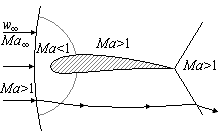Mach number
|
|
Mach number (Ma) is defined as a ratio of speed to the speed of sound in the medium in case. The Mach number is commonly used both with objects travelling at high speed in a fluid, and with high-speed fluid flows inside channels such as nozzles, diffusers or wind tunnels. As it is defined as a ratio of two speeds, it is a dimensionless number. At standard sea level conditions, Mach 1 is 1,225 km/h (765.6 MPH) in the atmosphere.
Since the speed of sound increases as the temperature increases, the actual speed of an object travelling at Mach 1 will depend on the fluid temperature around it.
It can be shown that the Mach number is also the ratio of inertial forces (also referred to aerodynamic forces) to elastic forces.
The Mach number is named after Austrian physicist and philosopher Ernst Mach.
High-speed flow around objects
High speed flight can be classified in five categories:
- Subsonic: M < 1
- Sonic: M = 1
- Supersonic: M > 1
- Transsonic: 0.8 < M < 1.3
- Hypersonic: M > 5
(For comparison: the required speed for low Earth orbit is ca. 7.5 km/s = Mach 22.06 in air at sea level)
At transsonic speeds, the flow field around the object includes both sub- and supersonic parts. The transsonic regime begins when first zones of Ma>1 flow appear around the object. In case of an airfoil (such as an aircraft's wing), this typically happens above the wing. Supersonic flow can decelerate back to subsonic only in a normal shock; this typically happens before the trailing edge. (Fig.1a)
As the velocity increases, the zone of Ma>1 flow increases towards both leading and trailing edges. As Ma=1 is reached and passed, the normal shock reaches the trailing edge and becomes a weak oblique shock: the flow decelerates over the shock, but remains supersonic. A normal shock is created ahead of the object, and the only subsonic zone in the flow field is a small area around the object's leading edge. (Fig.1b)

| 
|
| (a) | (b) |
Fig. 1. Mach number in transsonic airflow around an airfoil; Ma<1 (a) and Ma>1 (b).
When an aircraft exceeds Mach 1 (i.e. the sound barrier) a large pressure difference is created just in front of the aircraft. This abrupt pressure difference, called a shock wave, spreads backward and outward from the aircraft in a cone shape (a so-called Mach cone). It is this shock wave that causes the sonic boom heard as fast moving aircraft travels overhead. A person inside the aircraft will not hear this. The higher the speed, the more narrow the cone; at just over Ma=1 it is hardly a cone at all, but closer to a wall only slight bending backwards.
At fully supersonic velocity the shock wave starts to take its cone shape, and flow is either completely supersonic, or (in case of a blunt object), only a very small subsonic flow area remains between the object's nose and the shock wave it creates ahead of itself. (In the case of a sharp object, there is no air between the nose and the shock wave: the shock wave starts from the nose.)
As the Mach number increases, so does the strength of the shock wave and the Mach cone becomes increasingly narrow. As the fluid flow crosses the shock wave, its speed is reduced and temperature, pressure, and density increase. The stronger the shock, the greater the changes. At high enough Mach numbers the temperature increases so much over the shock that ionization and dissociation of gas molecules behind the shock wave begin. Such flows are called hypersonic.
It is clear that any object travelling at hypersonic velocities will likewise be exposed to the same extreme temperatures as the gas behind the nose shock wave, and hence choice of heat-resistant materials becomes important.
High-speed flow in a channel
As a flow in a channel crosses Ma=1 becomes supersonic, one significant change takes place. Common sense would lead one to expect that contracting the flow channel would increase the flow speed and at subsonic speeds this holds true. However, once the flow becomes supersonic, the relationship of flow area and speed is reversed: expanding the channel actually increases the speed.
The obvious result is that in order to accelerate a flow to supersonic, one needs a convergent-divergent nozzle, where the converging section accelerates the flow to Ma=1, and the diverging section continues the acceleration to supersonic. Such nozzles are called De Laval nozzles.de:Mach es:Número Mach eo:Maĥo fr:Nombre de Mach he:מספר מאך id:Mach it:numero di Mach nl:Machgetal no:Mach ja:マッハ pt:Mach pl:Liczba Macha sl:Machovo število fi:Mach sv:Mach zh-cn:马赫
